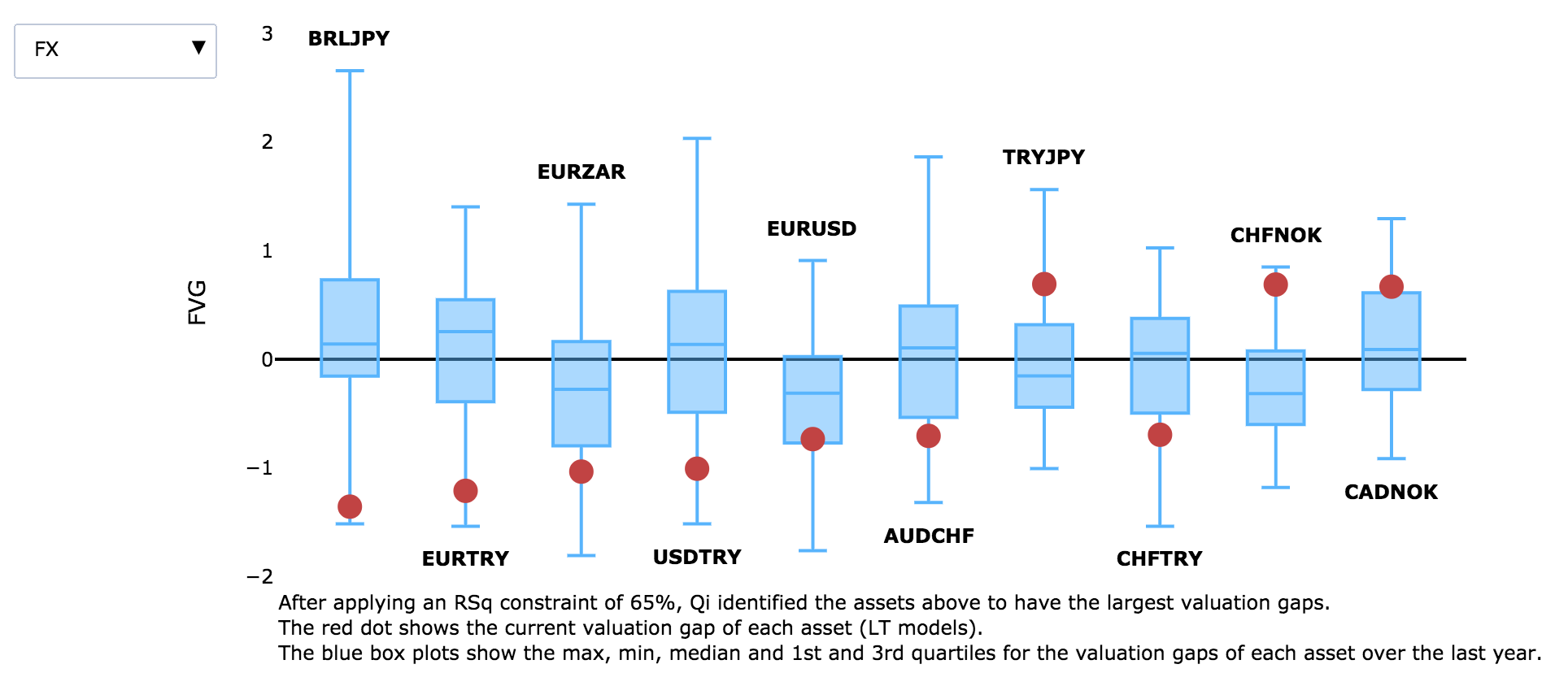28.11.2022
No margin for error
Qi highlights some vulnerabilities hiding under the surface of US equity markets.
The first amber warning sign – it is becoming harder to explain equity price action through macro forces alone.
Since early October, model confidence has been falling in eight of the eleven GICS Level 1 sectors. Indeed, only three of the eleven sectors have a model RSq > 65%.
Model confidence has been falling hardest in two of the leading sectors – Technology and Energy. While Technology still trades below its macro warranted value, LT model RSq has fallen to 60% from 74% one month ago. Energy model confidence has fallen 11% to only 52% now.
In the case of Energy, the sector has continued to outperform in this rally from October 12th despite crude falling over the same period. The divergence is notable with the sector 5.4% above model value albeit with falling model confidence.
The first amber warning sign – it is becoming harder to explain equity price action through macro forces alone.
Since early October, model confidence has been falling in eight of the eleven GICS Level 1 sectors. Indeed, only three of the eleven sectors have a model RSq > 65%.
Model confidence has been falling hardest in two of the leading sectors – Technology and Energy. While Technology still trades below its macro warranted value, LT model RSq has fallen to 60% from 74% one month ago. Energy model confidence has fallen 11% to only 52% now.
In the case of Energy, the sector has continued to outperform in this rally from October 12th despite crude falling over the same period. The divergence is notable with the sector 5.4% above model value albeit with falling model confidence.

The second amber warning sign - if model momentum has stalled in a leader of the market rally, value gap convergence is left vulnerable to changes in the macro backdrop.
Alongside falling model confidence, Qi’s model value for the Technology sector has flat-lined over the last month. A critical barometer of confidence in any Qi valuation gap is rising / stable model confidence alongside momentum in the model itself.
Macro conditions were improving for Technology over October but now they have stalled.
Alongside falling model confidence, Qi’s model value for the Technology sector has flat-lined over the last month. A critical barometer of confidence in any Qi valuation gap is rising / stable model confidence alongside momentum in the model itself.
Macro conditions were improving for Technology over October but now they have stalled.

The third amber warning sign – spreads are the dominant driver of the equity market in Qi’s models. However, has the reduction in risk premia left us with little margin for error?
Where model prices are rising (for example in Materials, Industrials) at the epicentre is the rally in credit spreads. Credit spreads saw their wides at the end of September and the equity low soon followed thereafter.
The largest driver of credit spreads are measures of risk aversion. The chart below shows the breakdown of macro drivers for US High Yield spreads. Risk aversion is the biggest accounting for 22% of model value.
A cursory glance of CDX HY and VIX would show both already at levels seen in mid-August when SPX was trading closer to 4200.
As another indicator of low risk premia, the SPX 12mth fwd earnings yield / bond yield gap is now at 15yr lows, last seen in 2007. One would reasonably expect that while rate volatility may well normalise next year, growth volatility will likely move higher - hence an almost unanimous Street focus on IG credit / balance sheet strength.
Where model prices are rising (for example in Materials, Industrials) at the epicentre is the rally in credit spreads. Credit spreads saw their wides at the end of September and the equity low soon followed thereafter.
The largest driver of credit spreads are measures of risk aversion. The chart below shows the breakdown of macro drivers for US High Yield spreads. Risk aversion is the biggest accounting for 22% of model value.
A cursory glance of CDX HY and VIX would show both already at levels seen in mid-August when SPX was trading closer to 4200.
As another indicator of low risk premia, the SPX 12mth fwd earnings yield / bond yield gap is now at 15yr lows, last seen in 2007. One would reasonably expect that while rate volatility may well normalise next year, growth volatility will likely move higher - hence an almost unanimous Street focus on IG credit / balance sheet strength.

The fourth warning sign – factors that contributed to rally strength may now come under pressure. Unless other factors come to the fore this in turn puts macro-warranted valuations under pressure.
We monitor for which drivers are increasing in importance to explain the equity market. USDCNH is now a top three driver of SPX model value over this last month after real yields and credit spreads.
After initial enthusiasm around a re-opening trade, China's daily Covid case has hit an all time high, large parts of Beijing are under effective lockdown & protests are spreading.
Commodity cyclicals (e.g. XME in addition to Copper and Energy) already screen as rich on Qi.
We monitor for which drivers are increasing in importance to explain the equity market. USDCNH is now a top three driver of SPX model value over this last month after real yields and credit spreads.
After initial enthusiasm around a re-opening trade, China's daily Covid case has hit an all time high, large parts of Beijing are under effective lockdown & protests are spreading.
Commodity cyclicals (e.g. XME in addition to Copper and Energy) already screen as rich on Qi.



